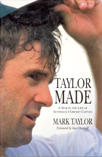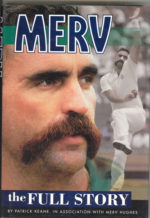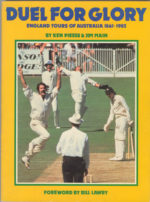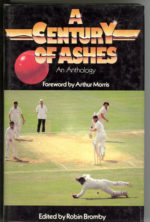Subtotal:
$1.10 (incl. tax)
Description
Foreword by Ian Chappell. Softback, 200-plus pages, Signed by the author bookplate neatly inserted inside
Expected late April-early May
Additional information
| Year Of Publication |
|---|
1 review for Nicholls, Barry – Playing to win, Australia and the 1972 Ashes
Add a review Cancel reply
You must be logged in to post a review.
Related products
-

Taylor, Mark – Taylor Made, signed by Mark
$16.50 Add to cart -

Keane, Patrick – Merv Hughes The Full Story, signed
$16.50 Add to cart -

Piesse, Ken – Duel for Glory, England tours of Australia (signed)
$11.00 Add to cart -
Sale!

Nicholson, Rod – Merv Hughes, special price
$11.00Original price was: $11.00.$2.20Current price is: $2.20. Add to cart





Ken –
Barry Nicholls talks about his latest book:
A captain ready to shake up the staid order of the Marylebone Cricket Club and a runaway fast bowler were the portents for England leading into the 1972 Ashes. That English summer would represent a transformative moment in Australian cricket history. Under Ian Chappell’s leadership, the game evolved from Bill Lawry’s conservative style to a more aggressive and attacking play. This shift not only reshaped the future of cricket in Australia but also left a lasting effect on the global cricketing landscape. The 1972 Ashes, therefore, holds a significant place in the annals of Australian cricket history.
The cancelled South African tour in 1971/72 (because of Apartheid) led to an unexpected turn of events. Australia took on the Rest of the World, captained by Garry Sobers, in a five ‘Test’ series at home. This twist in the cricketing narrative allowed the Australian selectors to experiment with various players in an entertaining but less pressured environment in preparation for the 1972 Ashes.
Controversy surrounded the 26th Australian touring party in England. Having discarded skipper Bill Lawry two summers earlier, the national selectors left him out of the touring party despite strong performances for Victoria. Veteran paceman Graham McKenzie and reliable batsman Ian Redpath were also omitted. Some in the press wondered if the push for youth had gone too far. As Norman Preston noted in Wisden, ‘Only seven of the seventeen who toured England in 1968 were retained.’
The Australian side was labelled the worst team to tour England. Given that England had the better of the Australians down under in 1970/71, this tour represented a chance to see if they had improved under Ian Chappell’s refreshing leadership.
I wrote Playing to Win: Australia and the 1972 Ashes to discover how this series led to Australia’s eventual ascension to world cricket’s peak. I also wanted to learn how the Australian squad viewed the tour retrospectively and discover more about the ‘lesser known’ players (e.g. Bruce Francis, David Colley, Jeff Hammond, Graeme Watson, etc.). Though not as famous as the Chappell brothers or Dennis Lillee, they played a part in the team’s overall success – their stories are often overlooked.
The wait for the first Test of the series was long. And wet.
The Australians arrived in London on April 17 and were scheduled to play 11 first-class matches before the first Test at Old Trafford on June 8. It vastly differed from the modern era’s relatively brief and fast-paced tours. Rain followed the Australians wherever they travelled. However, they weren’t the only ones frustrated by rain interruptions. The John Player League had 17 of the 30 matches scheduled in May reduced by rain.
In 1972, it became evident that Ian Chappell’s side also had charm and personality to burn. Their dynamite appeal entertained the audience and added an excitement that had been missing in Test cricket for nearly a decade. There was Ian Chappell’s unmistakable charisma and willingness to take the bowlers on from the first ball. Greg Chappell’s orthodox elegance with the bat, Dennis Lillee roaring in from 40 metres, intimidating the English top order. Rod Marsh’s boisterous enthusiasm behind the stumps and with the bat, while the bespectacled Ashley Mallett’s probing spinners added a more subtle flavour to the side’s attack.
The Australians had all the makings of a five-star movie cast.
When the tourists’ went one down in the series at Old Trafford, they picked themselves up and bounced back to win the Second Test at Lord’s in a match that featured Bob Massie’s prodigious swing bowling- where he captured 16 wickets on debut. The victory at Lord’s marked Australia’s first win in more than two and a half years and Ian Chappell’s first Test victory.
The 1972 Ashes was a rollercoaster of thrilling matches and unexpected performances. Four definitive results out of five Test matches. After the fusarium-affected pitch at Leeds, the Australians clinched the final Test at the Oval, drawing the rubber and proving they could stand toe-to-toe with any opposition.
By the end, the Australians had traversed most parts of the United Kingdom for almost six months. After five Test matches, 25 first-class and 11 non-first-class matches, the players finally made their way home.
As history shows, Australia eventually drew the series, which meant Ian Chappell at least retained the captaincy. If they had been defeated and the Australian skipper had a poor tour, Chappell could have lost the captaincy. It’s worth remembering that Australian cricket administrators had already marked Chappell’s card for his militant stance on player’s rights, revealed during the 1970 tour of South Africa (Bill Lawry was eventually banished after rejecting the South African Board’s offer of a Fifth Test match).
Had Ian Chappell failed on the 1972 tour of England, the World Series Cricket revolution established under businessman Kerry Packer five years later may never have happened or at least would have slowed. Could Packer have found a better Australian cricket ally than Ian Chappell? It’s hard to imagine one.
Chappell’s leadership enabled the flowering of Dennis Lillee, Rod Marsh and Greg Chappell’s talent, stamping them as world-class players. While an adequate opening partnership had yet to be discovered, Australia’s top order had transitioned from brittle to no longer intimidated by opposition pace attacks. Ross Edwards emerged as a solid middle-order batsman for Australia, and Ashley Mallett arrived as an off-spinner of class (despite his previous successes in India).
Australia was on its way to becoming a force in world cricket. The Test and County Cricket Board also had cause for celebration, with 370,000 spectators paying a world record of half a million dollars (Australian) to watch the series.
On a personal note, that northern English summer captivated me as a ten-year-old and sparked a deep engagement with the game. For many men now in their 60s, the tour was their first significant introduction to Test cricket. Australian fans were delighted with the half-hour TV Test highlights on Channel Two. I saved up my pocket money to buy the ABC cricket ‘book,’ complete with player profiles, scorecards, and statistics. The cover features Dennis Lillee bowling in a staged shot with the white-coated umpire craning slightly to the right, checking to see if the Australian paceman is overstepping. Although it’s faded and torn, I still have my copy 53 years later.
The 1972 Ashes represented my first deep dive into Australian cricket. There was also an undeniable mystique surrounding a tour played 16,000 km away. In Australia, morning reports on ABC radio provided a talking point over breakfast for my father and me before he rushed off to walk the 3 km to the bus stop on Greenhill Road from our house in Beaumont. That bus then took him to the Weapons Research Establishment at Salisbury, a half hour north of Adelaide, where he worked as a scientist designing and testing rockets. When he wearily walked up Lascelles Avenue to our home, sometime after 6 pm, I would meet him halfway down the steep incline.
Later that year, Ian Chappell’s account of the tour Tigers Among the Lions was found under the Nicholls family Christmas tree. It was the first book I read, and completing it relieved my parents, knowing I could concentrate long enough to finish a book. Ian Chappell’s description of the tour matches, Tests and some off-field activities added detail and colour to the places visited and the players featured. It all happened over 50 years ago, but it somehow feels like yesterday.